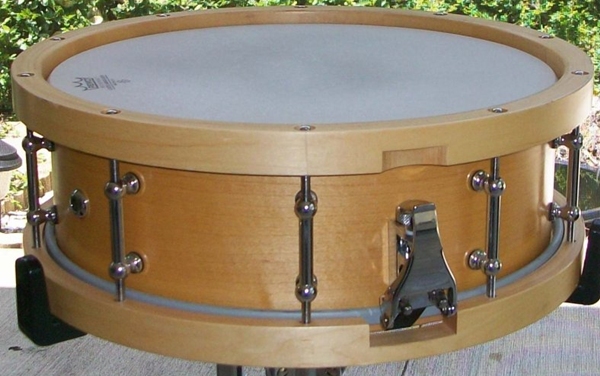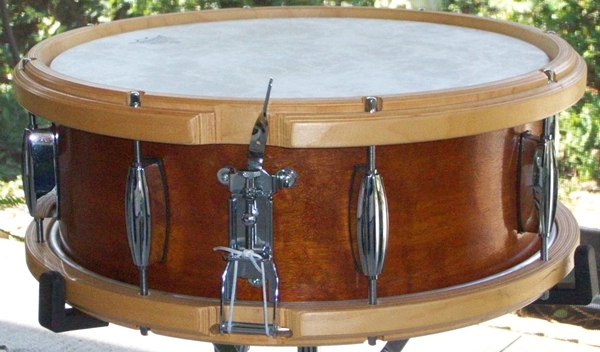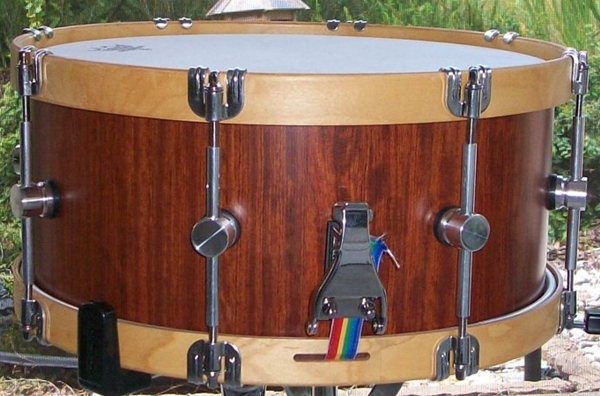Not all hoops are created equal. There are four basic types:
- Yamaha style, which are thick. PDP also makes this type of hoop, as do a few custom wood hoop makers.
- Shaped style, which is basically the Yamaha style that has been shaped to resemble - as best as can be done - a regular drum hoop.
- Straight, which is similar to the metal band and wood hoops used on early drums.
- Hide-A-Hoop, which is similar to the straight style, but has a counter groove cut to fit over the flesh hoop on drum heads in the same manner as a double-flanged hoop on 1930s-1940s snare drums (see this post for more information.)

The shaped head shown in this photo is a compromise - you still have lots of wood and tone, but you gain back a modicum of sensitivity:


I no longer have any snare drums with the straight hoop on them, but the one I had and sold had the characteristic warmth of wood hoops and was extremely sensitive to the edge of the head. The straight hoops are usually thinner than the Hide-A-Hoop style, and are not as durable in my opinion. On the plus side, though, is some models can be used with regular lugs, whereas the Hide-A-Head style typically requires spacers under the lugs to move them far enough from the shell to accommodate the increased outside diameter of the hoops. This increase is due to the way the Hide-A-Hoop hoop is designed to mate with the head's flesh hoop.
The Hide-A-Head hoop, like the straight hoop, gives drums a warmth while not significantly hampering sensitivity or shell resonance. Here is a snare drum and a kit configured with this hoop style:


Personally, I love the tone, durability (this hoop is slightly thicker than the straight hoop), and sensitivity of this particular hoop.
There are a few things you need to consider when purchasing Hide-A-Head hoops:
- Thickness - will the mini-claws fit it? I had to sand down parts of these hoops from some sources to get the mini-claws that are shown in the above photo to fit over the hoop. If you are using a bass drum claw this isn't a problem.
- Before rushing out and grabbing a set make sure you have a strategy for adding spacers to your lugs so that they protrude far enough off the shell to accept the tension rods into the lug receivers. If you are using tube lugs, be aware that they are not forgiving of tolerance errors.
- Be prepared to spend money. You need more than just hoops - you will need claws, longer tension rods and lug spacers. These add up quickly, so carefully cost it out before purchasing the hoops. Also, if you decide to use the mini-claws that are shown in the above photos, you may find that they are nearly impossible to get. There are times when they are readily available from multiple sources, and other times when you cannot get them amywhere.
The choices are many, but the nice thing about hoops is they can be swapped out to quickly change the characteristics of a snare drum. While I have enough snare drums to just grab the right one for a particular room, just having an extra set of hoops to throw on for specific playing situations makes a lot more sense than having an extra snare drum. Any of the hoop styles, and especially the Yamaha and shaped ones, will tame down a snare drum that is a bit too lively for a room when it has normal hoops. Plus, playing a wood hoop snare drum (or kit) is fun!
4 comments:
thanks for taking the time to write this. i found this article very informative
Thanks for the post. It helped me a lot. I just bought a Wooden Hoop.
Regards.
HI thanks for writing this, was very informative. I'm thinking of getting some wood hoops for a Gretsch maple snare I have, and like the look and response characteristics you mentioned of the "contoured" hoops. Are the hoops in the second photo from top available from Stellar ?
Yes, the hoops in the second photo are from Stellar. They are the 32-ply hoops offered by them. When placing an order you have the option for 'shaping', which is how they describe their contouring.
Post a Comment